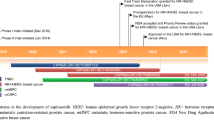Abstract
Background
The primary objective was to study the antitumor activity of prolonged subcutaneous dosing of systemic 852A, a Toll-like receptor-7 agonist (TLR-7), in recurrent breast, ovarian and cervix cancer. Secondary objectives included assessment of safety and immune system activation.
Methods
Adults with recurrent breast, ovarian or cervix cancer failing multiple therapies received 0.6 mg/m2 of 852A subcutaneously twice weekly for 12 weeks. Doses increased by 0.2 mg/m2/week to a maximum of 1.2 mg/m2. Serum was collected to assess immune activation.
Results
Fifteen patients enrolled: 10 ovarian, 2 cervix and 3 breast. Three completed all 24 injections. There were two grade 2 (decreased ejection fractions), nine grade 3 (1 cardiovascular, 1 anorexia, 3 dehydration, 2 infections, 2 renal) and two grade 4 (hepatic and troponin elevation) unanticipated toxicities. Cardiac toxicities included three cardiomyopathies (2 asymptomatic) and one stress-related non-ST elevated myocardial infarction. Five patients discontinued therapy due to possibly associated side effects. One who had stable disease (SD) following 24 doses received 17 additional doses. A cervix patient with SD following 24 doses received chemotherapy after progressing 3 months later, and remains disease free at 18 months. Immune activation, as evidenced by increased IP-10 and IL-1ra, was observed.
Conclusions
In this first human experience of a TLR-7 agonist delivered subcutaneously using a prolonged dosing schedule, 852A demonstrated sustained tolerability in some patients. Clinical benefit was modest, but immune activation was seen suggesting further study of antitumor applications is warranted. Because of cardiac toxicity; 852A should be used cautiously in heavily pretreated patients.

Similar content being viewed by others
References
Krieg AM (2002) CpG motifs in bacterial DNA and their immune effects. Annu Rev Immunol 20:709–760
Kokkinopoulos I, Jordan WJ, Ritter MA (2005) Toll-like receptor mRNA expression patterns in human dendritic cells and monocytes. Mol Immunol 42:957–968
Miller RL, Gerster JF, Owens ML et al (1999) Imiquimod applied topically: a novel immune response modifier and new class of drug. Int J Immunopharmacol 21:1–14
Chen M, Griffith BP, Lucia HL, Hsiung GD (1988) Efficacy of S26308 against guinea pig cytomegalovirus infection. Antimicrob Agents Chemother 32:678–683
Bernstein DI, Harrison CJ, Tomai MA, Miller RL (2001) Daily or weekly therapy with resiquimod (R-848) reduces genital recurrences in herpes simplex virus-infected guinea pigs during and after treatment. J Infect Dis 183:844–849
Hemmi H, Kaisho T, Takeuchi O et al (2002) Small anti-viral compounds activate immune cells via the TLR7 MyD88-dependent signaling pathway. Nat Immunol 3:196–200
Wenzel J, Uerlich M, Haller O et al (2005) Enhanced type I interferon signaling and recruitment of chemokine receptor CXCR3-expressing lymphocytes into the skin following treatment with the TLR7-agonist imiquimod. J Cutan Pathol 32:257–262
Meyer T, Nindl I, Schmook T et al (2003) Induction of apoptosis by Toll-like receptor-7 agonist in tissue cultures. Br J Dermatol 149(Suppl 66):9–14
Dudek AZYC, Harrison LI, Kumar S, Hawkinson R et al (2007) First in human phase I trial of 852A, a novel systemic Toll-like receptor 7 agonist, to activate innate immune responses in patients with advanced cancer. Clin Cancer Res 13:7119–7125
Harrison LI, Astry C, Kumar S, Yunis C (2007) Pharmacokinetics of 852A, an imidazoquinoline Toll-like receptor 7-specific agonist, following intravenous, subcutaneous, and oral administrations in humans. J Clin Pharmacol 47:962–969
Schiller M, Metze D, Luger TA et al (2006) Immune response modifiers—mode of action. Exp Dermatol 15:331–341
Gorden KB, Gorski KS, Gibson SJ et al (2005) Synthetic TLR agonists reveal functional differences between human TLR7 and TLR8. J Immunol 174:1259–1268
Gangur V, Simons FE, Hayglass KT (1998) Human IP-10 selectively promotes dominance of polyclonally activated and environmental antigen-driven IFN-gamma over IL-4 responses. Faseb J 12:705–713
Yoneyama H, Narumi S, Zhang Y et al (2002) Pivotal role of dendritic cell-derived CXCL10 in the retention of T helper cell 1 lymphocytes in secondary lymph nodes. J Exp Med 195:1257–1266
Schroder K, Hertzog PJ, Ravasi T, Hume DA (2004) Interferon-gamma: an overview of signals, mechanisms and functions. J Leukoc Biol 75:163–189
Taub DD, Sayers TJ, Carter CR, Ortaldo JR (1995) Alpha and beta chemokines induce NK cell migration and enhance NK-mediated cytolysis. J Immunol 155:3877–3888
Disis ML (2002) Immunologic targets for breast cancer. Breast Dis 15:83–90
Hengge UR, Roth S, Tannapfel A (2005) Topical imiquimod to treat recurrent breast cancer. Breast Cancer Res Treat 94:93–94
Adams M, Navabi H, Croston D et al (2005) The rationale for combined chemo/immunotherapy using a Toll-like receptor 3 (TLR3) agonist and tumour-derived exosomes in advanced ovarian cancer. Vaccine 23:2374–2378
Diaz-Arrastia C, Arany I, Robazetti SC et al (2001) Clinical and molecular responses in high-grade intraepithelial neoplasia treated with topical imiquimod 5%. Clin Cancer Res 7:3031–3033
Dummer R, Hauschild A, Becker JC et al (2008) An exploratory study of systemic administration of the Toll-like receptor-7 agonist 852A in patients with refractory metastatic melanoma. Clin Cancer Res 14:856–864
Bonomi P, Blessing JA, Stehman FB et al (1985) Randomized trial of three cisplatin dose schedules in squamous-cell carcinoma of the cervix: a Gynecologic Oncology Group study. J Clin Oncol 3:1079–1085
Acknowledgments
This study was initially supported by 3M. 3M oncology programs were acquired by Coley in June 2007 and Coley provided financial support for MUGA scans performed as part of the trial. Coley was acquired by Pfizer Inc in November 2007. Additional support was provided by the Minnesota Ovarian Cancer Alliance.
Conflict of interest
The authors declare that they have no conflict of interest
Author information
Authors and Affiliations
Corresponding author
Additional information
M. A. Geller and S. Cooley contributed equally to this work.
Rights and permissions
About this article
Cite this article
Geller, M.A., Cooley, S., Argenta, P.A. et al. Toll-like receptor-7 agonist administered subcutaneously in a prolonged dosing schedule in heavily pretreated recurrent breast, ovarian, and cervix cancers. Cancer Immunol Immunother 59, 1877–1884 (2010). https://doi.org/10.1007/s00262-010-0914-1
Received:
Accepted:
Published:
Issue Date:
DOI: https://doi.org/10.1007/s00262-010-0914-1




